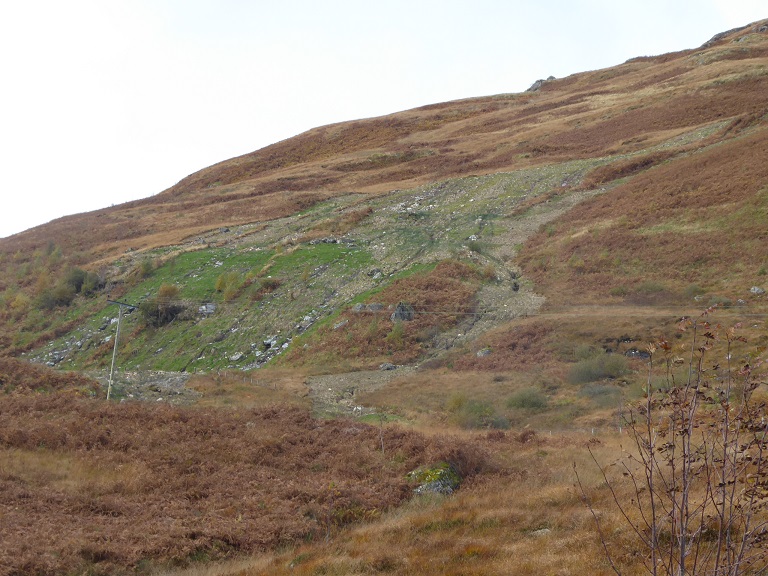
My initial focus on the damage caused by the torrential rainfall at the start of August was on Glen Falloch, where I was surprised by the extent of the landslips (see here)and the damage to the hydro schemes (see here). A reader who lives in the Trossachs gently reminded me a few weeks ago that the Stronachlachar Road was still closed. I have visited Strathard twice since but the first time got caught up in looking at camping and access issues (see here).

I did see evidence of several recent landslips, however, including this one above houses. Scary for the people living there and enough to make me want to return. Yesterday I did so, after observing the Loch Lomond and Trossachs National Park Authority Board Meeting which took place in Kinlochard Village Hall in the morning. The main item on their agenda, which is highly relevant to what follows, was approval of their “Trees and Woodland Strategy”.
I had intended to take a closer look at the landslips in Glen Gyle, which had received press coverage (see here for example), but the road from Stronachlachar to Glen Gyle along the shore of Loch Katrine was closed to pedestrians. The civil engineering works required to repair the damage are still ongoing 3 months later. I saw enough though to realise that the damage done by the storm was even more extensive than that in Glen Falloch just over the watershed. So why the political and media silence?
This post takes a look at the issues and argues that the LLTNPA, Forestry Scotland and the Environment Minister, Roseanna Cunningham, should set up a public inquiry to investigate what’s happened and recommend appropriate actions.
What’s caused the landslips?
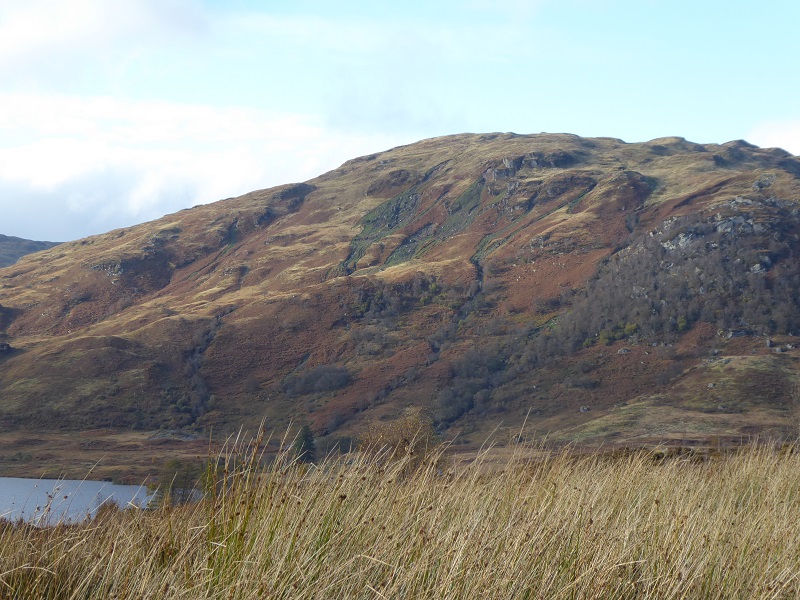
While there are isolated individual landslips, there are also areas where large section of hillside have been affected (as in photo above). In places all the soil that has accumulated since the glaciers melted has been swept away. That should provide pause for thought.

Many of the landslips, including that in the very first photo, started ABOVE the current tree line and, just like avalanches, appear to have been triggered by a relatively small area of slope “failing”:
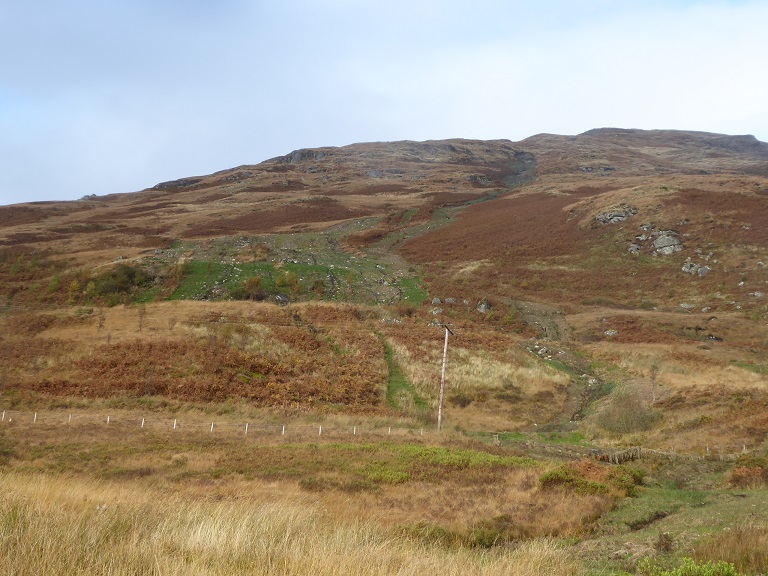
In these cases it appears that overgrazing by deer and sheep is likely to have been a contributory factor to the slope failure:
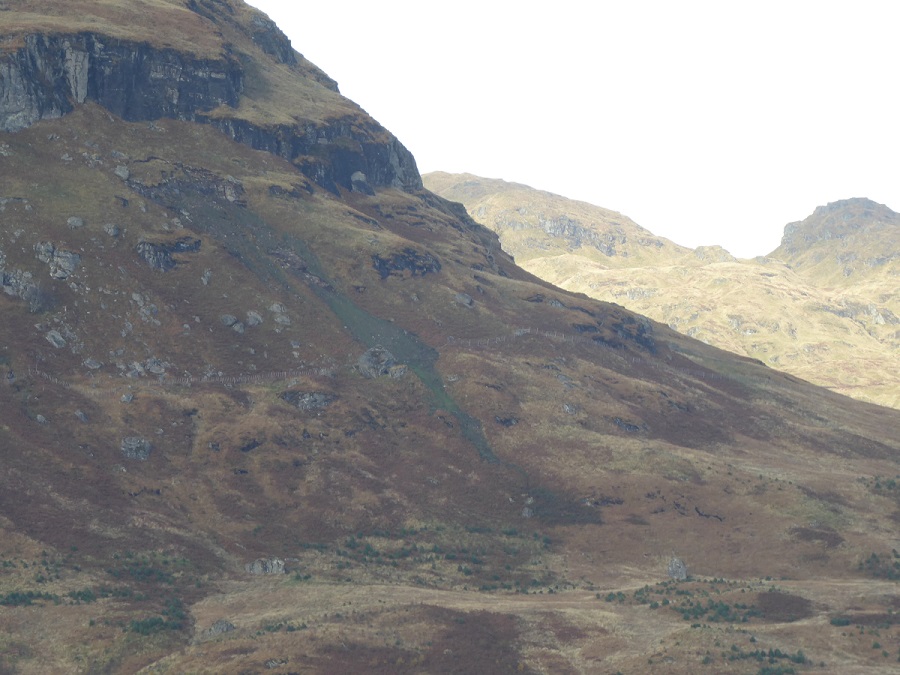
ALL this land is owned by Forest and Land Scotland. That they have had to erect deer fences on land they own is an indication of the problem. It suggests they are not managing deer numbers and without the fences all the new trees they are planting (2.5m trees in the first ten years of the project) would get eaten.
This land is not only publicly owned, its also within the Greater Trossachs Forest. The Scottish Government declared this a new National Nature Reserve, the largest in Scotland, in 2015, despite the limited nature of the nature conservation interest.

The Great Trossachs Forest has been portrayed as the jewel in the crown of the Scottish Forestry Alliance which claimed that “this landscape will be transformed, returning heavily grazed land and plantation forestry to a more natural mix of habitats, including areas of moorland, montane, wetland
and pasture.” As a partner in this alliance Forest and Land Scotland should know that deer fencing creates unnatural landscapes, grazed on the one side and not on the other.
Continued high levels of deer grazing is preventing trees from growing further up the hill and a montane scrub zone from developing. The long history of overgrazing has helped create the thin depleted soils some of which were washed away in the storm event. Trees help soils develop. Both help retain water. Forest and Land should also know this. Its ironic therefore that some of trees which they have planted have been destroyed by landslips originating from above, caused in part by their failure to bring deer numbers down. Quite a contrast to Wild Land Ltd in Glen Feshie which has radically reduced deer numbers, where trees are regenerating naturally without any need for fencing and where other wildlife is now starting to flourish. A contract too to how FLS are trying to manage their own land at Invereshie which, like Wildland Ltd, is part of the Cairngorms Connect Project.
This failure to bring deer numbers down would also appear to have contributed to the extensive damage that has been done to human infrastructure, buildings and roads, at the head of Glen Gyle. One wonders how many £millions this has cost so far to repair? Has Scottish Water and the insurance companies picked up the tab or has Forest and Land Scotland agreed partial liability for what has happened?
One wonders too what the impact has been on Glasgow’s water supply? Part of the original justification for the Great Trossachs Forest was it would help improve water quality in Loch Katrine, which provides drinking water to a significant proportion of the population in Scotland. What has been the response of the Scottish Environment Protection Agency and Scottish Water to all the soil and debris swept down by the storm event at the head of Glen Gyle into the public water supply?
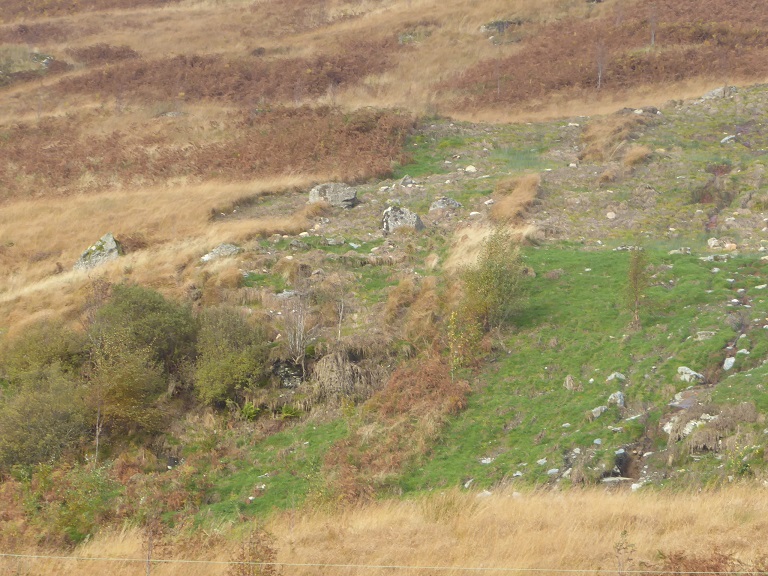
Deer fencing is a sign of failure. There is a strong argument that it should be abandoned completely as that would force all landowners to address overgrazing issues as Wildland Ltd have done in Glen Feshie. At the very least, however, fencing should never be allowed on a National Nature Reserve. Its lamentable that Scottish Ministers and SNH decided to designate the Great Trossachs Forest as an NNR without any proper plans to address deer numbers or allow a montane scrub zone to develop.

Why haven’t the trees done more to prevent the landslips?
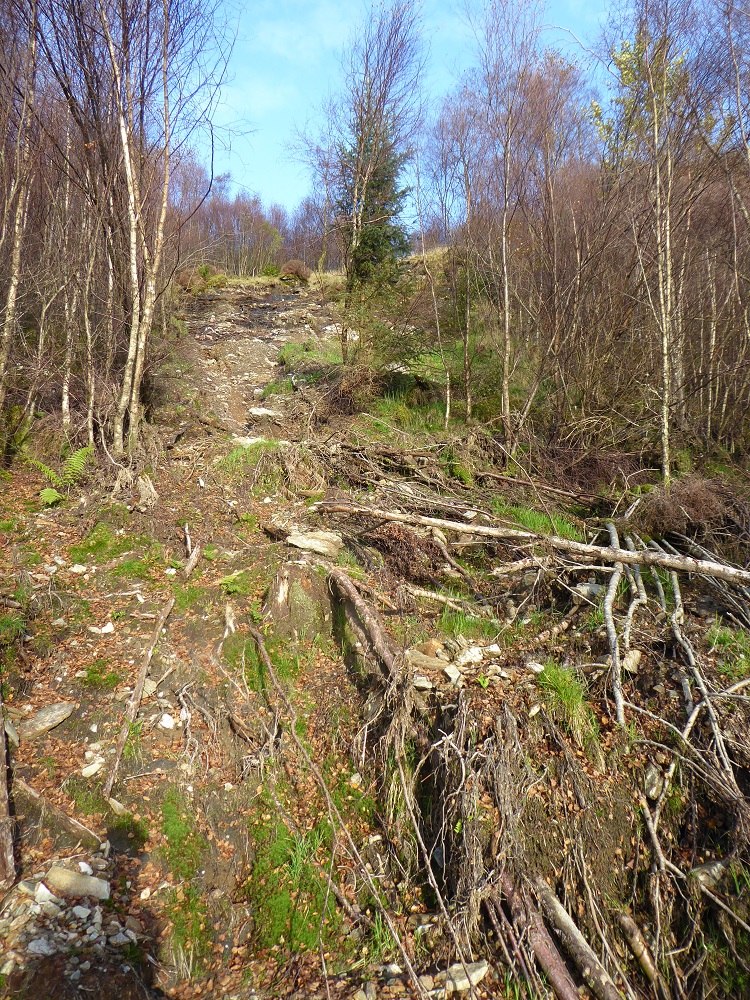
While the woodland on Meall Mheadhonach did not prevent the landslip, it did eventually help bring it to a halt:
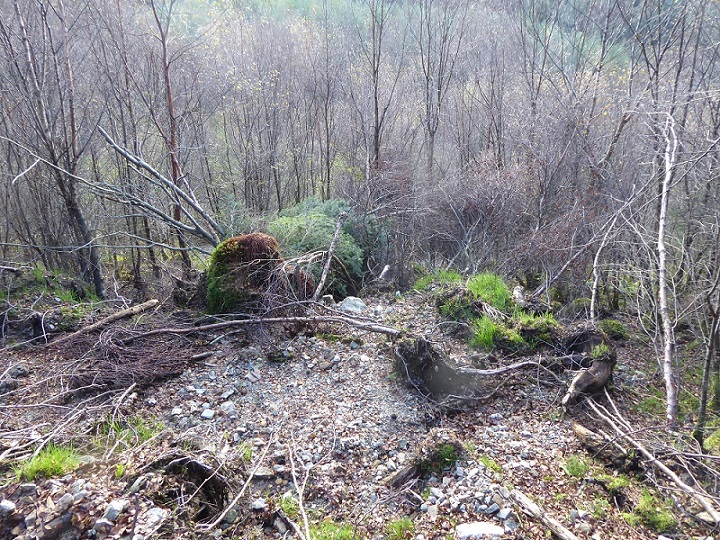
The tree blockage was formed by trees swept down in the landslip coming up against trees lower down which were bowled over but not uprooted. The public footpath is just below this.
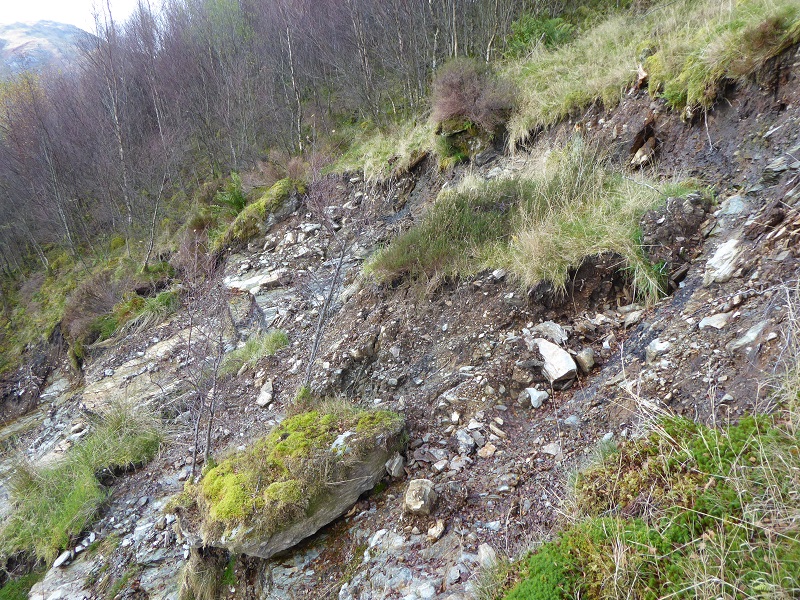
Trees clearly don’t in themselves prevent landslips from being triggered. The issue is partly one of very shallow soils – marvel on how little soil this birch is growing – but also linked to the age and type of trees. Only some trees put down deep tap roots which might have helped hold this slope together and they need time to do so. If we want to reduce the incidence of landslips in the uplands through tree regeneration we should not expect it to work immediately. That’s why we need to address the overgrazing issue as part of the Climate Emergency NOW. Even if the Scottish Government and our public agencies started to act immediately, it will take years for trees to grow sufficiently to have maximum impact and even longer (100s of years) for soils to develop from their present thin coverings.
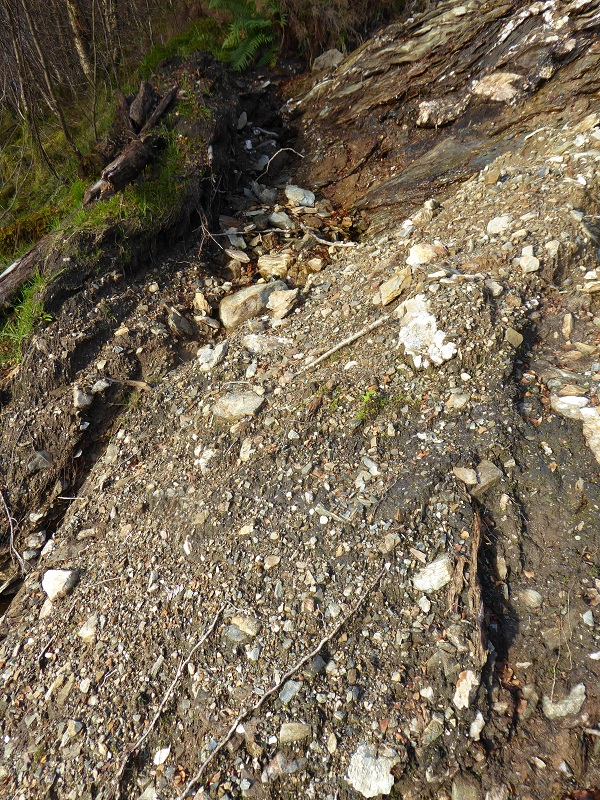
That doesn’t mean to say young trees are useless for preventing landslips, only that that root systems have limited effect.
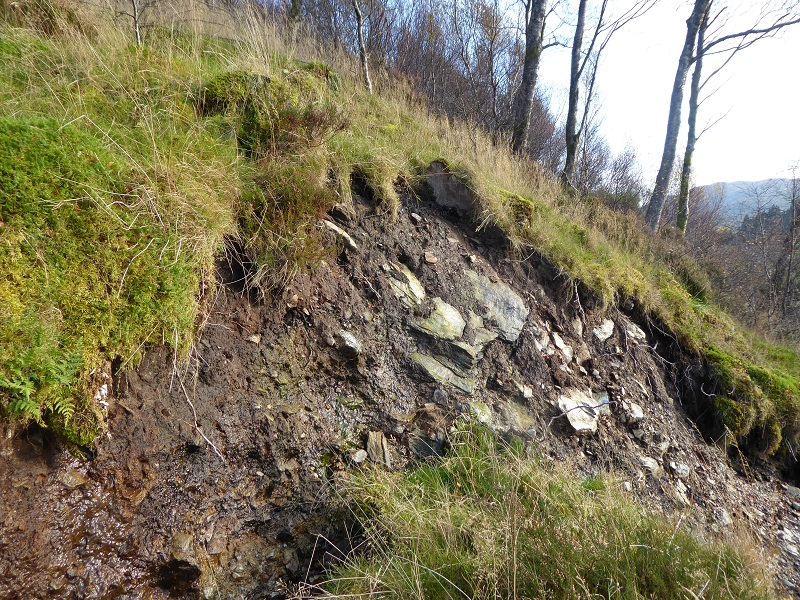
The slope above the landslip was quite limited in extent, probably less than 100m to the watershed. That is an indication – as in the landslips that started near the top of the open hillsides – of the intensity of the rainfall. As such extreme events become more common in Scotland, as has been happening with climate change, landslips are likely to increase whatever we do.
We urgently need to commission work/research on the relationship between extreme flood events and different types of land cover from overgrazed hillsides to forested slopes and what causes slopes to give way. At Meall Mheadonach, for example, there was a “headwall” like in an avalanche and plenty of evidence to help experts determine why the landslip happened here. That work then needs to be used to inform future land management. The LLTNPA has a key role here – they were supposed to be the lead Public Authority for natural flood management in the Lomond Catchment but have not commissioned any research as yet because of lack on money.
What’s going wrong and what needs to happen
It appears obvious that it would be in the public interest if geomorphologists, soil scientists and others with ecological expertise were commissioned to investigate and report on the impact of the storm event in Glen Falloch and the Trossachs and set out options for the future. Lessons learned could then be applied not just to the National Park but the whole of Scotland. The obvious lead for this would be the LLTNPA supported by Scottish Forestry and the Scottish Government.
Unfortunately, for several reasons, this appears unlikely to happen without public and political pressure.
Firstly, because a public inquiry would be an acknowledgement of failure by the Scottish Government and a host of public agencies in respect of the way land has been managed and how developments (run of river hydro schemes) have been promoted without any proper consideration of their “sustainability”. All of the land affected by the extreme rainfall in the Trossachs is PUBLICLY owned and most of it is in a National Nature Reserve. This would be a cause of considerable embarrassment to a the Scottish Government departments responsible for the environment, protected areas, rural affairs and planning as well as Forestry Scotland (which regulates the forestry sector), Forest and Land Scotland (which owns the land), SNH, SEPA , Scottish Water and the LLTNPA. The culture of all these agencies is to muddle through behind the scenes rather than admit mistakes and tackle the sources of problems.
Secondly, because while all these public agencies have a multitude of references to “natural flood management” at a policy level, action on the ground is limited and tends to concentrated on the lower ground where they are re-creating marshes and trying to protect flood plains. An example this week was Scottish Natural Heritage’s announcement that:
“We were delighted to host 18 colleagues from across Europe on a recent study tour by the Eurosite Wetlands and Climate Change working group, visiting sites across central Scotland to find out how we are using wetlands to help buffer the impacts of ongoing climate change” (see here)
This is all very worthy and worthwhile but avoids the fundamental issue which is how we slow down the flow of water, most of which falls in the uplands, BEFORE it reaches the wetlands. That, however, would mean tackling land use in the uplands and more particularly landowners, overgrazing by Red Deer and the destruction associated with grouse moors. A good illustration of how feart SNH is to tackle the real issues was their announcement 10 days ago that they were planning to plant the Beinn Eighe National Nature Reserve as their contribution to tackling climate change. Parkswatch contributor, Dave Morris, provided an excellent critique of this in a letter to the Herald (see here). Too weak to take on landowners and other agencies, all SNH can do is plant its own land thereby wrecking it. All it needed to do was to tackle the deer issue and there would be no need to plant.
Thirdly, both the Scottish Government and the LLTNPA have locked themselves into “Forest Strategies” which are full of great words but rely on the market to deliver and are based on tree planting rather than natural regeneration. While the LLTNPA’s Trees and Woodland strategy approved yesterday refers to natural regeneration as a preferred method of forest expansion for native woodland (such as is being developed in the Great Trossachs NNR) and also refers to overgrazing, it contains NO measures to reduce deer numbers. A missed opportunity.
However, there is some hope. Jo O’Hara, Chief Executive of Forestry Scotland, was invited to speak at the meeting about the Strategy – an indication that the forest industry rather than the National Park is in the driving seat – but she indicated that the Declaration of a Climate Emergency by the Scottish Government means that Scotland’s Forest Strategy 2019-29 is already out of date.
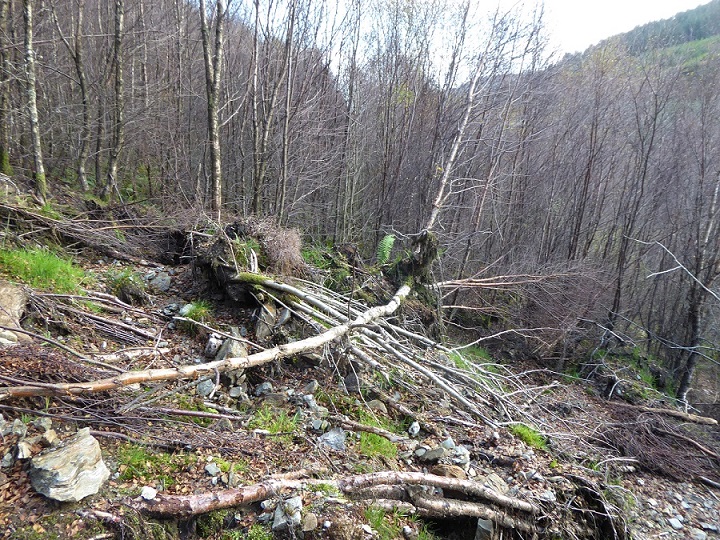
Ms O’Hara and Board Member Clare Chapman, who comes from SEPA, were the two people at the meeting to raise and discuss the issue of the role of woodland in preventing flood damage. Ms O’Hara gave a short explanation of how far behind Europe we are in terms of “protection forestry” and how we need to learn. (Such forest is generally managed in Europe through natural regeneration and by keeping numbers of grazing animals down). The impact of the August storm on the Great Trossachs Forest would provide the perfect case study to inform what needs to change. Time for Forestry Scotland and the LLTNPA to be brave, admit to mistakes and commission a quick investigation by experts to come up with plans to tackle the issues.

Excellent article linking Poor deer management , forests, landslips and flooding. Thanks Nick.
While the connection between the lack of tree cover on higher slopes and numbers of Red deer and sheep which graze there is accepted, there is so much more to this. Herds of Highland red deer are not static..they move considerable distances. Decades of research has been conducted across Europe – Mind boggling scientific papers published: an attempt to number crunch available statistics for debate by endless committees ? .
At a more local level it is very hard indeed for any land manager of any upland area to control grazing of slopes they have control over, without resorting to fences. Put simply, on the days when shooting on neighbouring ground takes place, deer will move to zones and slopes where they feel less threatened. To escape threats or starvation they may swim rivers, or across lochs. After each seasons’ cull it takes just a few weeks for survivors across this natural region to move back to repopulate ‘vacated’ spaces that may result from a seasonal cull. As far as any fresh plantation is concerned, deer have only to browse a sapling once or twice every 5 years and a mature tree will never exist. Over 17 years on this small property we have kept one area deer fenced off. It has now regenerated naturally to become a small woodland.( some additional saplings saved from council mowers and forest machines, from along nearby roadsides are added each year ). Land we have control of outside this 3 acres remains open hillside. We watch Deer swimming and jumping over any low barrier, as they migrate to fresh ‘pastures’ where they feel less threatened. It is quite hopeless to attempt to attempt to cull them all or to regenerate any forest area on any ‘barren hillsides’ without resorting to high fences. It would be wonderful if it were.
Hi Tom, I don’t doubt its almost impossible for small landholdings to grow trees without fences when surrounding landowners are not culling deer. However, if you have not seen it you should go to Glen Feshie and other Wild Land Estates where there are now very few fences – they are systematically being removed – and trees are regenerating everywhere. They do have, as you say, a continued problem of deer moving in – mostly from Atholl where deer numbers are far too high – but they keep on culling and the positive impact this has for other wildlife and biodiversity is amazing. In the Trossachs, there is a huge area of publicly/conservation organisation owned land and – with similar determination and an approach to Wild Land Ltd, natural regeneration would work. Indeed it is evident on some slopes already – ironically those OUTSIDE the area declared a National Nature Reserve eg above Aberfoyle and on south side of Strathard. Nick